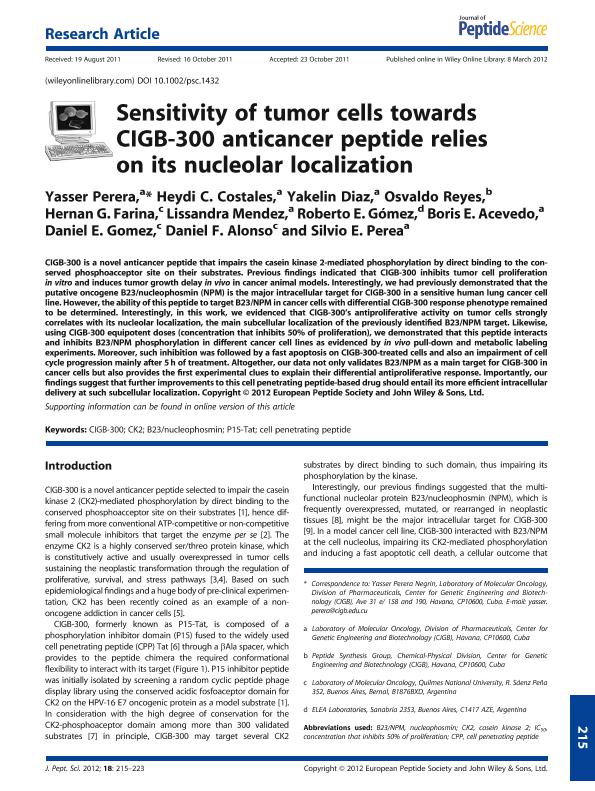Mostrar el registro sencillo del ítem
dc.contributor.author
Perera, Yasser
dc.contributor.author
Costales, Heydi C.
dc.contributor.author
Diaz, Yakelin
dc.contributor.author
Reyes, Osvaldo
dc.contributor.author
Farina, Hernán Gabriel

dc.contributor.author
Mendez, Lissandra
dc.contributor.author
Gómez, Roberto E.
dc.contributor.author
Acevedo, Boris E.
dc.contributor.author
Gomez, Daniel Eduardo

dc.contributor.author
Alonso, Daniel Fernando

dc.contributor.author
Perea, Silvio E.
dc.date.available
2023-04-04T11:29:56Z
dc.date.issued
2012-04
dc.identifier.citation
Perera, Yasser; Costales, Heydi C.; Diaz, Yakelin; Reyes, Osvaldo; Farina, Hernán Gabriel; et al.; Sensitivity of tumor cells towards CIGB-300 anticancer peptide relies on its nucleolar localization; John Wiley & Sons Ltd; Journal Of Peptide Science; 18; 4; 4-2012; 215-223
dc.identifier.issn
1075-2617
dc.identifier.uri
http://hdl.handle.net/11336/192586
dc.description.abstract
CIGB-300 is a novel anticancer peptide that impairs the casein kinase 2-mediated phosphorylation by direct binding to the conserved phosphoacceptor site on their substrates. Previous findings indicated that CIGB-300 inhibits tumor cell proliferation in vitro and induces tumor growth delay in vivo in cancer animal models. Interestingly, we had previously demonstrated that the putative oncogene B23/nucleophosmin (NPM) is the major intracellular target for CIGB-300 in a sensitive human lung cancer cell line. However, the ability of this peptide to target B23/NPM in cancer cells with differential CIGB-300 response phenotype remained to be determined. Interestingly, in this work, we evidenced that CIGB-300's antiproliferative activity on tumor cells strongly correlates with its nucleolar localization, the main subcellular localization of the previously identified B23/NPM target. Likewise, using CIGB-300 equipotent doses (concentration that inhibits 50% of proliferation), we demonstrated that this peptide interacts and inhibits B23/NPM phosphorylation in different cancer cell lines as evidenced by in vivo pull-down and metabolic labeling experiments. Moreover, such inhibition was followed by a fast apoptosis on CIGB-300-treated cells and also an impairment of cell cycle progression mainly after 5 h of treatment. Altogether, our data not only validates B23/NPM as a main target for CIGB-300 in cancer cells but also provides the first experimental clues to explain their differential antiproliferative response. Importantly, our findings suggest that further improvements to this cell penetrating peptide-based drug should entail its more efficient intracellular delivery at such subcellular localization.
dc.format
application/pdf
dc.language.iso
eng
dc.publisher
John Wiley & Sons Ltd

dc.rights
info:eu-repo/semantics/openAccess
dc.rights.uri
https://creativecommons.org/licenses/by-nc-sa/2.5/ar/
dc.subject
B23/NUCLEOPHOSMIN
dc.subject
CELL PENETRATING PEPTIDE
dc.subject
CIGB-300
dc.subject
CK2
dc.subject
P15-TAT
dc.subject.classification
Tecnologías que involucran la manipulación de células, tejidos, órganos o todo el organismo

dc.subject.classification
Biotecnología de la Salud

dc.subject.classification
CIENCIAS MÉDICAS Y DE LA SALUD

dc.title
Sensitivity of tumor cells towards CIGB-300 anticancer peptide relies on its nucleolar localization
dc.type
info:eu-repo/semantics/article
dc.type
info:ar-repo/semantics/artículo
dc.type
info:eu-repo/semantics/publishedVersion
dc.date.updated
2023-04-03T12:07:37Z
dc.journal.volume
18
dc.journal.number
4
dc.journal.pagination
215-223
dc.journal.pais
Reino Unido

dc.journal.ciudad
Londres
dc.description.fil
Fil: Perera, Yasser. Centro de Ingeniería Genética y Biotecnología; Cuba
dc.description.fil
Fil: Costales, Heydi C.. Centro de Ingeniería Genética y Biotecnología; Cuba
dc.description.fil
Fil: Diaz, Yakelin. Centro de Ingeniería Genética y Biotecnología; Cuba
dc.description.fil
Fil: Reyes, Osvaldo. Centro de Ingeniería Genética y Biotecnología; Cuba
dc.description.fil
Fil: Farina, Hernán Gabriel. Universidad Nacional de Quilmes. Departamento de Ciencia y Tecnología. Laboratorio de Oncología Molecular; Argentina. Consejo Nacional de Investigaciones Científicas y Técnicas; Argentina
dc.description.fil
Fil: Mendez, Lissandra. Centro de Ingeniería Genética y Biotecnología; Cuba
dc.description.fil
Fil: Gómez, Roberto E.. Centro de Ingeniería Genética y Biotecnología; Cuba
dc.description.fil
Fil: Acevedo, Boris E.. Centro de Ingeniería Genética y Biotecnología; Cuba
dc.description.fil
Fil: Gomez, Daniel Eduardo. Universidad Nacional de Quilmes. Departamento de Ciencia y Tecnología. Laboratorio de Oncología Molecular; Argentina. Consejo Nacional de Investigaciones Científicas y Técnicas; Argentina
dc.description.fil
Fil: Alonso, Daniel Fernando. Universidad Nacional de Quilmes. Departamento de Ciencia y Tecnología. Laboratorio de Oncología Molecular; Argentina. Consejo Nacional de Investigaciones Científicas y Técnicas; Argentina
dc.description.fil
Fil: Perea, Silvio E.. Centro de Ingeniería Genética y Biotecnología; Cuba
dc.journal.title
Journal Of Peptide Science

dc.relation.alternativeid
info:eu-repo/semantics/altIdentifier/url/https://onlinelibrary.wiley.com/doi/10.1002/psc.1432
dc.relation.alternativeid
info:eu-repo/semantics/altIdentifier/doi/http://dx.doi.org/10.1002/psc.1432
Archivos asociados
